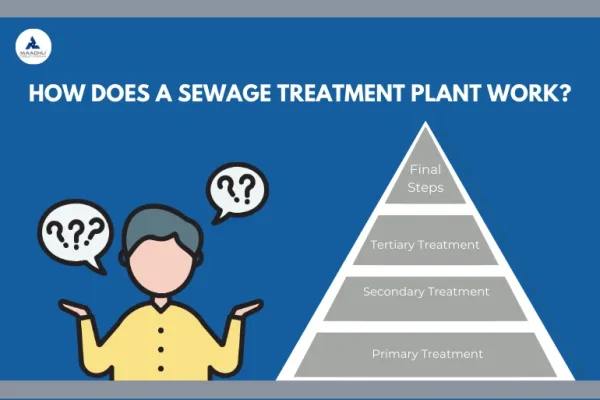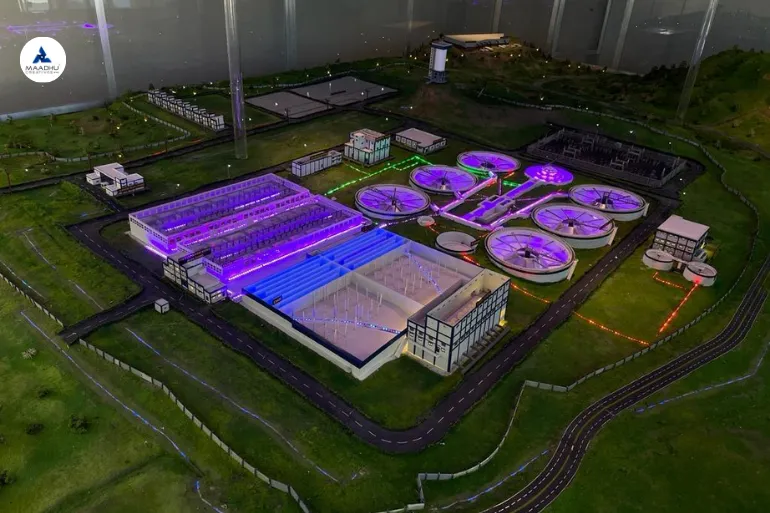The Essential Role of Sewage Treatment Plants: How They Work
Table of Contents
STPs stands for Sewage Treatment Plants that are important assets of today’s world, dealing with waste water produced from residential buildings, commercial properties, and industries. If the populations of cities continue to increase and industries develop, the significance of proper waste water treatment also rises. This blog will discuss what sewage treatment plants are, how the plants work, the different types available, and why the plants are important in promoting public health and preventing pollution.
What Is Meant By A Sewage Treatment Plant?
A waste water treatment plant is therefore an establishment that has the capacity of treating waste water that has been used so that it can be released back to society. The waste water is collected from households, businesses, and industries, among others. Final products known as STPs are designed to discharge safe water free from pollutants into rivers, lakes, or oceans.
Importance of Sewage Treatment Plants
Sewage treatment plants serve several critical functions that highlight their importance in contemporary society:
- Public Health Protection: Raw sewage contains many pathogens that pose a great threat to human health and are likely to cause waterborne diseases such as cholera, dysentery, and hepatitis. Since sewage contains pathogenic bacteria, viruses, and protozoa that cause these diseases, STPs have a very important role in protecting community health by treating sewage.
- Environmental Conservation: Regulations have it that STPs notably diminish the quantity of pollutants in natural water sources. These serve to prevent toxic materials, including heavy metals, organic chemicals, and disease-causing bacteria, from polluting the rivers and oceans, therefore preserving the aquatic life and habitat.
- Resource Recovery: Most of the current STPs are intended to reuse water and recover useful nutrients such as nitrogen and phosphate from the sewage. It also enhances sustainability because the reclaimed water can be used to irrigate crops or as industrial water without the need for fresh water sources.
- Economic Benefits: Sewage treatment can be costly, but if done right, it can work in favor of municipalities to a large extent. Availability of high-technology treatment options also means that more lives will be saved, incidences of water-borne illnesses will decrease, and the expenses to address pollution will be decreased.
How Does a Sewage Treatment Plant Work?
The functioning of a sewage remedy plant can be broken down into several levels, each playing a selected function in cleansing the water. The essential tiers of remedy encompass primary, secondary, and tertiary strategies.

1. Primary Treatment
The first process in the treatment of this waste product is called Sesage primary treatment, which aims at removing large soli and other materials that are floating on the surface of the sewage. This process typically includes:
- Screening: The first part of the system involves the use of screens that physically scrub the sewage through mechanical barriers to remove large items like twigs, bottles, papers, plastics, and any other large solid waste. This helps in saving equipment used in the other stages from getting damaged.
- Sedimentation: They are subjected to screening where the sewage flows into a sedimentation tank. Here, there is decelerated flow, so heavy solid drops out on the bottom of the vessel. This settled material creates sludge, and the rest is composed of lighter materials such as grease and oils that are normally skimmed off the top.
2. Secondary Treatment
In secondary treatment, the main concern is the removal of soluble and emulsifiable materials through bacterial action. This stage typically includes:
- Activated Sludge Process: In this most popular technique, compressed air is forced to flow through aeration chambers holding diluted sewage and activated sludge (bacteria). These bacteria obtain nutrients from the organic matter and decompose them into relatively smaller fragments. The mixture is then allowed to settle in a secondary clarifier following a given retention time, after which the treated water is separated from the sludge.
- Trickling Filter: In this system, there is use of sewage spraying down on the rocks or the plastic media. Actually, microorganisms develop on the surface of the media and decompose the organic matter as the water filtrates. This method is used frequently in small plants, and under some circumstances, this method may be more effective.
3. Tertiary Treatment
The last phase of water treatment, typically referred to as tertiary or advanced treatment, is meant to provide a higher level of water purification before the water is released into the environment. This stage may include:
- Filtration: Subsequently, using secondary treatment, water can still contain particle size in the effluent stream. The last treatment involves filtration through sand, gravel, or membrane systems to get rid of these remaining solids, hence producing clean effluent.
- Disinfection: The treated water is also disinfected in order to ensure that if there are any pathogens in the water, they are killed. Some of the most popular forms of disinfection are the use of chlorine, ultraviolet light, or ozone. This process is important in order to be very sure that the water that is let to flow in the environment is clean.
- Nutrient Removal: Some plants deal with the removal of nutrients such as nitrogen and phosphate, which cause water pollution when they get into natural water systems, resulting in problems like algae bloom.
Final Steps
When water has gone through all the treatment procedures, it can be discharged on other water bodies or utilized for watering crops, several industrial uses, or even for recreational purposes. The solids formed during primary and secondary treatment may have to pass through other stages like anaerobic digestion to minimize their volume and make them safe for discharge.
Different Models of Waste water Treatment Plants
Sewage treatment plants are of different types, based on the features of the sewage that is to be treated by the respective plant. Here are some common models:Here are some common models:
Conventional Activated Sludge System
To date, this is the common model of the sewage treatment plant. It comprises aeration tanks, which include the sewage mixed with activated sludge and the microorganisms. It is effective in disintegrating the organic matter and compatible with large communities, hence suitable for use in urban cities.
Sequencing Batch Reactor (SBR)
They are operated on a batch basis, unlike the SBR model, which is a type of waste water treatment system. This helped in exercising greater control over the treatment process and is ideal for use in situations where the flow of sewage is countering. In this process, it has four phases, which are filling, reacting, settling, and decanting phases, which makes it more flexible in its functioning.
Membrane Bioreactor (MBR)
The MBR model involved the use of the biological treatment process together with membrane filtration. This approach provides good-quality effluent since the membranes inhibit any particles suspended in water from passing through but instead retain substances such as bacteria and algae. MBRs are most applicable in urban areas since they occupy a small space as compared to the conventional systems.
Compact Sewage Treatment Plants
It is implemented for the production of electricity in areas such as rural or remote where big stations cannot be constructed. Small-scale STPs can effectively clean the waste water without much physical and technical development, hence being suitable for small societies.
Sewage Treatment Plant Model Making
Building a model of a sewage treatment plant could be one of the best ways through which such facilities can be explained. Here’s a simple guide to making one: Here’s a simple guide to making one:
Materials Needed For Waste Water Treatment Plant Model Making
- Milk container bottles (to symbolize various treatment processes)
- Small pumps (for the purpose of giving an imitation of water flow).
- Pipe (to join several sections of the model)
- Representatives of filtration (filters)
- Flow charts (or captions) (to describe each phase)
The Steps for building your model
- Design Your Model: The first step that should be taken when modeling your sewage treatment plant is to draw a layout plan. Determine which part of the plant should be for screening, sedimentation, aeration, filtration, and disinfection.
- Gather Materials: According to your design, gather all the relevant materials that are required in the creation of your logo. Make sure that there are ample containers available to represent the different stages involved in the treatment process.
- Build the Model: Connect the parts in the manner that you want your structure to be arranged such that water could pass through in the process of treatment.
- Demonstrate the Process: For instance, to show how contaminants are removed at this stage, use colored water. It will make the audience comprehend the efficiency of the treatment process depicted in the picture.
The Environmental and Social Effects of Sewage Treatment Plants
The technical aspects of sewage treatment plants are therefore closely connected to vast environmental and social implications as well.
Environmental Benefits
- Protection of Water Bodies: Since STPs are able to remove pollutants from the sewage before it is discharged, it is able to reduce pollution levels of rivers and oceans. They take action to preserve the health of the various water systems and the species that inhabit them.
- Reduction of Eutrophication: Eutrophication is looking for a process where there is mostly nitrogen and phosphorus that enter the bodies of water and cause an increase in the growth of algae. Since these nutrients are stripped off during the water treatment process by the stps, this occurrence is averted, something that could be catastrophic to water life.
- Recycling and Reuse of Water: Most of the STPs have been designed to be capable of providing waste water treatment services to a level that they can be used in irrigation or industries, and even, in some cases, for drinking. This recycling helps preserve water, mainly fresh water, thus being eco-friendly.
Social Benefits
- Improved Public Health: Through stopping raw sewage from entering water supply and contact with other people, STPs play a very important role in preserving people’s lives. This results in saving on costs incurred in combating water-related diseases.
- Community Awareness and Engagement: The intervention of treatment of sewage therefore focuses the everyday knowledge of communities on environmental sustainability as well as the sustainable health of the public. Such knowledge promotes more participation of people in the environmental activities within their area.
- Economic Opportunities: Sewage treatment plants could mean job opportunities in the construction, development, and management of the plants. Also, the treated water will enable farming and other related practices, thus contributing positively to the economy of the region.
Conclusion
Sewage treatment plants are standard facilities that are critical in enhancing and conserving public health, the environment, and other resources. These facilities play a significant role in improving the quality of water in the environment as well as for human use. Without knowing the way they work and the importance they hold, their use becomes a mystery to us.
It is therefore important to embrace modern sewage treatment technologies because there are issues like climate change and population growth. By improving waste management systems as a priority, we can create a better future for our planet and ensure continued availability of the most important water sources.
FAQs About Sewage Treatment Plant Model
- Sewage treatment plant construction requires site, design, and provision of the plant, along with environmental standards in place. It is thus important to seek advice from the environmental engineers.
To design a treatment plant, knowledge of the characteristics of waste water, state/federal regulations, and required level of treatment needs to be known. It is important to cooperate with experienced engineers when designing.
Sewage works are the installations where the water received from pre-treatment processes undergoes other processes like screening, biological treatment, and disinfection to enable proper disposal of the water.
The four categories are mechanical (screening and sedimentation), biological (activated sludge and trickling filters), chemical (coagulation and disinfection), and advanced techniques (membrane filtration).









